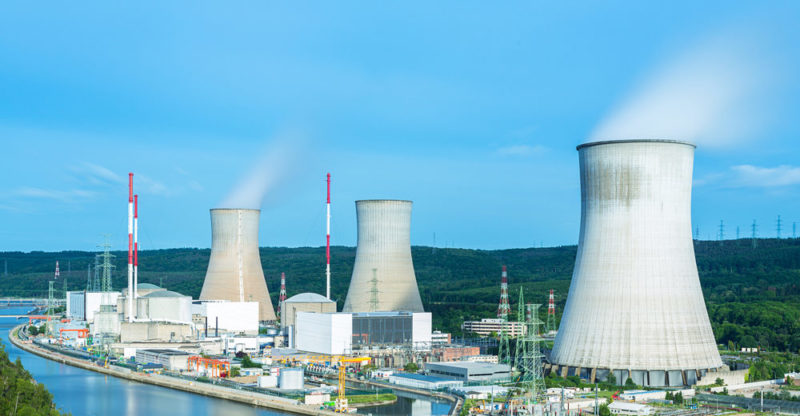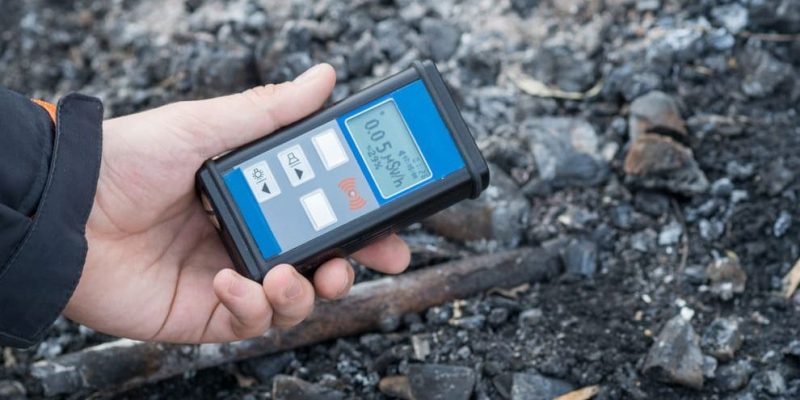We explain what radioactive contamination is and what its causes and consequences are. Also, its features and solutions.
What is radioactive contamination?
Radioactive (or radioactive) contamination, or also nuclear contamination, is the unwanted presence of radioactive substances or materials in a given ecosystem. They can be natural or artificial isotopes, which cause serious chemical or biological alterations, and can lodge inside bodies.
Radioactivity is a property possessed by certain chemical elements, which do not present an adequate balance between their subatomic particles in the nucleus (protons and neutrons). Because of this lack of stability, the particles are emitted out of the atom as a way to release excess energy and mass and become a more stable element.
This process, called radioactive decay, emits alpha, beta, gamma, and neutron radiation . They can pass through matter and alter its molecular constitution. Its effect can be lethal to the delicate chemical balance of life . This process takes fractions of a second for some elements, while for others it can take thousands of years.
Radioactive elements
Among the most common radioactive elements are:
- Polonium (Po)
- Astat (At)
- Radon (Rd)
- Francio (Fr)
- Radius (Ra)
- Actinium (Ac)
- Thorium (Th)
- Uranium (U)
- Plutonium (Pu)
- Neptunium (Np)
- Lawrencio (Lr)
- Berkelium (Bk)
- Californium (Cf)
Causes of radioactive contamination
 The main causes of radioactive contamination are artificial, that is, they are due to errors or human actions, such as:
The main causes of radioactive contamination are artificial, that is, they are due to errors or human actions, such as:
- Atomic bombs. Fortunately, only two have been thrown in history on human populations, and the consequences can be seen to this day in the descendants of Hiroshima and Nagasaki in Japan. On the other hand, thousands of nuclear tests have been carried out in various uninhabited places around the world, leaving a radioactive footprint and causing considerable ecological damage.
- Medical practices. Radioactive substances are often used in medicine as markers for examinations or as therapeutic treatment in cases of cancer (radiotherapy). The incorrect arrangement of these elements can generate contamination.
- Nuclear waste management. The problem with nuclear power plants is that they generate materials like plutonium (Pu), a highly radioactive heavy metal that takes at least 88 years to decompose (there are isotopes that take up to 24,100 years) to break down into lead. This implies the complicated disposal of highly polluting radioactive waste.
- Nuclear accidents. Technical failures in power plants or other accidents with nuclear equipment tend to produce massive contamination in neighboring areas, throwing radioactive chemical material that is highly dangerous to live into the air, water, and soil.
Consequences of radioactive contamination
 Radiation is energy not only lethal but also mutagenic, that is, capable of altering the functioning of vital DNA in unpredictable ways. For this reason, radioactive contamination is considered one of the most dangerous possible.
Radiation is energy not only lethal but also mutagenic, that is, capable of altering the functioning of vital DNA in unpredictable ways. For this reason, radioactive contamination is considered one of the most dangerous possible.No life form remains immune to its effects. These include cancer, leukemia, infertility, and fetal malformations. In some cases, it can lead to immediate death or hereditary transmission of birth defects.
How can radioactive contamination be avoided?
Prevention is often the best measure to avoid radioactive contamination. To do this, it is necessary:
- Strict laws regarding the use of hazardous materials, which include strong safety and prevention measures, as well as clear and responsible measures in case of accidents or disasters.
- Strict laws regarding the disposal of radioactive waste in the best way and in isolated areas.
- Investing in energy sources that are safer than atomic energy.
- Environmental education for the population and especially in the recognition of radiation and its signals.
- Inform workers and residents regarding the use of this type of material in any medical, industrial or energy facility and its risks.
Possible solutions for radioactive contamination
 Once radioactive contamination has occurred, there is little that can be done. Generally, sanitation measures involve isolating the contaminated region to avoid the spread of toxic elements.
Once radioactive contamination has occurred, there is little that can be done. Generally, sanitation measures involve isolating the contaminated region to avoid the spread of toxic elements.Another option is the collection of the polluting material and its disposal in lead barrels, which is one of the materials that best resist radiation. These wastes are subsequently deposited in dry and secluded places, waiting for the end of their half-life.
Levels of contamination risk
In nature, there is no element without a certain margin of radioactivity. On the other hand, the Earth is constantly bombarded by harmful types of radiation, from which our atmosphere and magnetosphere protect us.However, if we talk about particularly radioactive materials, exposure to them can be classified into two risk levels:
- Low exposure. Low levels of exposure imply less risk, although this depends on the specific nature of the radioactive agent. Their effects on life thus depend on the absorbed dose, and unless one is repeatedly exposed to them, their risks should be low, as the human body can get rid of them through feces, urine, and sweat.
- High exposure. High levels of exposure, either from the continuous presence of radioactive material or from highly toxic elements, pose serious risks to people and the environment. These substances are fixed in the body in amounts that are impossible to purge, causing cancerous tumors, transmittable genetic damage, or, simply, death in a short time. It all depends on how high the levels received are.
How is radioactive contamination measured?
 The unit established in the International System (SI) to measure radioactivity is the Becquerelium (Bq) , equivalent to 1 decay per second. Previously, Curium (Ci) was used, which was identified with the activity of one gram of radium (Ra).
The unit established in the International System (SI) to measure radioactivity is the Becquerelium (Bq) , equivalent to 1 decay per second. Previously, Curium (Ci) was used, which was identified with the activity of one gram of radium (Ra).This measurement can express two types of contamination:
- Superficial. Contamination is expressed in units of area, such as becquerels per square meter (Bq / m 2 ). It is occurring in soil and the skin of the people.
- Volumetric. Contamination is expressed in units of volume, such as becquerels per cubic meter (Bq / m 3 ). It is useful to measure the contamination of territories or closed environments.
Types of radioactive contamination
In principle, two types of radioactive contamination are distinguished, according to their origin:
- Natural pollution. It can occur due to the appearance or abundance on the earth's surface of radioactive elements that are a natural part of terrestrial or atmospheric cycles. For example, those that are constantly generated by the bombardment of cosmic rays from outer space.
- Artificial pollution. These cases depend on human activity, especially warfare and energy, such as atomic bombs or nuclear power plants. In them there are physicochemical processes that generate radioactive materials, being able by mistake to release them to the surrounding environment. These materials are generally synthetic and do not exist in the natural world, so there are no safe levels of their presence in the ecosystem.
Warning symbols
 The international symbol of radioactive contamination is a central black circle from which three triangular wings protrude. They usually have a yellow background with a triangular shape, as danger signs usually have.
The international symbol of radioactive contamination is a central black circle from which three triangular wings protrude. They usually have a yellow background with a triangular shape, as danger signs usually have.In some cases, depending on the severity of the contamination risk, this symbol may be illustrated in green (low risk), yellow (medium risk), orange (medium-high risk), or red (maximum risk).
Examples of radioactive contamination
- The Chernobyl accident. In 1986, at the nuclear plant near the city of Pripyat in present-day Ukraine, one of its reactor cores overheated during a power failure test. This led to a series of errors that ended up releasing into the atmosphere an amount of uranium dioxide, boron carbide, europium oxide, erbium, and alloys of zirconium and graphite that had a radioactive effect of 500 times the atomic bombs of Hiroshima and Nagasaki. . This affected kilometers around and the aforementioned city had to be totally evacuated, still being a ghost town and uninhabitable today.
- The Fukushima accident. Similar to the Chernobyl accident, it took place in Japan during the 2011 earthquake and tsunami. A mass of radioactive iodine was produced in the sea near the plant and the plutonium was thrown around the reactor, contaminating the milk of the cows of the region and the spinach harvested not too far away. These levels of toxic cesium and iodine reached as far as the air in Finland and the US.
The above content published at Collaborative Research Group is for informational and educational purposes only and has been developed by referring to reliable sources and recommendations from technology experts. We do not have any contact with official entities nor do we intend to replace the information that they emit.
Luke is passionate about fostering student involvement and connection. He studied psychology for his major and likes learning about the past. Luke aims to specialize in artificial intelligence and cybersecurity. .
Leave a reply
Your email address will not be published. Required fields are marked *Recent post

Sport: What Is It, Types, Risks, Features, Characteristics and Examples

Dogs: Emergence, Features, Characteristics, Feeding and Breeds

Story: Definition, Elements, Structure, Features and Characteristics

